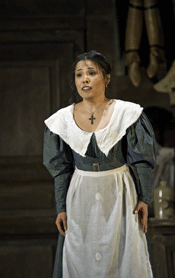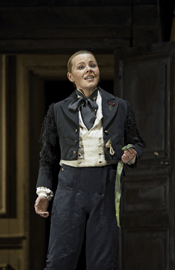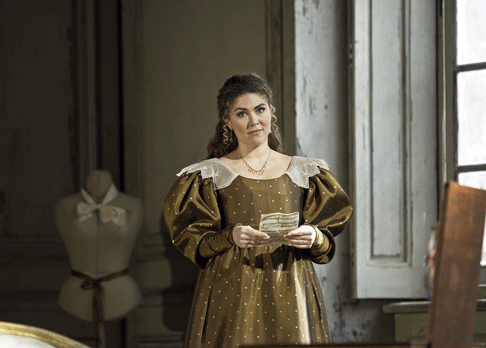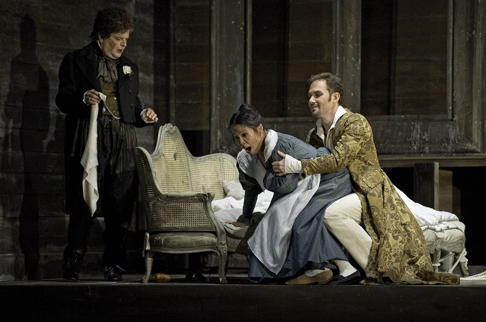Under
the stern gaze of butlers and house-keepers, footmen and maids dart efficiently
about the stage, tidying, carrying, dusting; this is a well-run household where
everyone knows their place and their job. Well, almost everyone … for
while the household machinery runs smoothly in the background, McVicar
foregrounds the potential misery and heartache which may result from
cross-class interactions of an amorous nature between servants and their
imperious masters.
Upon this production’s first appearance in 2006, much was made of
McVicar’s decision to ‘update’ the action to the 1830s. But
this minor historical shift is neither especially remarkable nor inappropriate,
for the focus here is not political conflict but human passions. And, this
vision surely penetrates to the heart of this opera: for all its French
Revolutionary origins, it is at essence a tale of amorous confusions and
betrayals … it is in Don Giovanni (where the class divides are
just as obvious, and further highlighted by contrasting musical idioms) that we
hear the revolutionary cries of “Viva la libertÈ!”, whereas
Figaro explores human emotions — love, lust, envy, treachery
— as encapsulated by the Count’s words, ‘Shall I live to see
a servant of mine happy and enjoying pleasure that I desire in vain?’
 Eri Nakamura as Susanna
Eri Nakamura as Susanna
The spacious stage, with widened proscenium arch, comfortably accommodates
Tanya McCallin’s inventive sets, which slide ingeniously to emphasise the
contrast between the luxurious grace of the courtly rooms and the shabby jumble
of the servants’ quarters, while also revealing the co-dependence of the
two worlds. In the Act 1 Trio, ‘Cosa sento!’, when the enraged
Count discovers the unfortunate page, Cherubino, hiding in Susanna’s
room, servants listen avidly outside the door, relishing the commotion within.
As the Count rants, rages and plans revenge in ‘Hai gi‡ vinta la
causa!’, butlers and housemaids silently go about their business,
diplomatically deaf to their master’s indiscreet outpourings.
McVicar is alert to every potential for realism: there are some neat
contemporary references — Count Almaviva inspects some new scientific
machinery at the start of Act 3, for example — and there is not an
anachronism or improbability in sight. With this particular Susanna a good foot
shorter than the Countess, disguise and mistaken identity become more
improbable, so McVicar stands his Susanna on a box, just one example of the
understated dramatic integrity of the whole.
The transitions between locations are imperceptible and creative, none more
so that between Acts 3 and 4, where the imposing interior smoothly and almost
indiscernibly transforms to become a nocturnal garden, beautifully and
evocatively lit by Paule Constable.
The performances of the fairly young cast of principals were similarly
well-matched, marked by musical accuracy and dramatic credibility. Erwin
Schrott as Figaro sang with naturalism and ease: his perturbed servant is not
an over-confident, boastful buffoon, but rather a man of cool intelligence and
wit, who really is in control of the commotion. Although he lacks some power in
the lower range, Schrott’s performance is impressive and unceasingly
entertaining. There is not a wasted moment or irrelevant gesture, as when he
quick-wittedly improvises a limp when his lies about leaping from the
Countess’s window are almost uncovered by the Count. When the hunting
fanfares trill out in ‘Aprite un po’ quegli occhi’, Schrott
waggles his cuckold’s horns, but while his horror at Susanna’s
imagined infidelity seems genuine at this point, we are confident that he will
manage events to his benefit; and his wry comic nuance in the ensuing
denouement was superb.
 Jurgita Adamonyt? as Cherubino
Jurgita Adamonyt? as Cherubino
In an unusually vicious interpretation, Mariusz Kwiecien was a portrait of
pride and brutal petulance as Count Almaviva. This was really dramatic singing.
Drawing upon a wide range of colours in his Act 3 aria, ‘VedrÚ,
mentr’io sospiro’, Kwiecien suggested not a petty
aristrocrat’s frustration at not getting his own way, but genuine fury
and ferocity. However, the surprising slap which he inflicted upon the Countess
during their argument about Cherubino’s whereabouts seemed inappropriate
— such nastiness and intimated cruelty is hard to reconcile with their
apparently harmonious reunion at the close of the opera.
Eri Nakamura is still a Jette Parker Young Artist but she showed musical
maturity, and stamina, as Susanna. Secure and poised throughout, she held her
own among more her experienced colleagues. However, it was a pity that, when Da
Ponte’s libretto contributes so much to the wit and irony of the opera,
her Italian was almost unintelligible! Jurgita Adamonytė convincingly
conveyed Cherubino’s restless energy and capacity for mischief. Her
intonation was secure, her tone crisp and clear, and she shaped Mozart’s
lyrical lines in ‘Voi che sapete’ with grace; but while she dashed
gauchely about the stage, vocally perhaps she was a bit too elegant and
controlled, not quite capturing Cherubino’s breathless excitement and
urgency.
German soprano, Annette Dasch, was making her ROH debut as the Countess.
Although she was a little nervous and unsteady at the start, she relaxed after
a slightly strained ‘Porgi amor’, and blended sweetly with Nakamura
in their Act 3 Canzonetta. However, ‘Dove sono’ was a little too
pressing and tense for my liking; accompanied by wonderful woodwind playing,
Dasch lacked richness at the top of her voice and in the climactic closing
phrases pushed to forcefully to the top As, lacking somewhat the composure and
restraint required to suggest the Countess’s deeply felt but poignant
regret.
 Annette Dasch as Countess Almaviva
Annette Dasch as Countess Almaviva
Marie McLaughlin is an experienced Marcellina and she was clearly
comfortable in the role, enjoying the on-stage business and singing with bright
tone and precision — it was a pity that her Act 4 aria was cut.
McLaughlin’s sense of timing was more than equalled by Robert Lloyd as
Bartolo, and they made a wonderful comic pair, the latter despatching the
prattling patter of ‘La vendetta’ with ease.
Peter Hoare was a suitably snide and sneering Basilio, although he might
have made even more of his comic moments, such as the repetition of his line,
‘What I said about the page, it was just a suspicion …’ in
‘Cosa Sento’. Nicholas Folwell’s Antonio was convincingly
furious at having his flowerbeds trampled by Cherubino, and certainly not keen
on acquiring him as a son-in-law! American soprano, Amanda Forsythe,
confidently delivered Barbarina’s Act 4 aria with polished style and
lovely refinement, and Christopher Gillett was a very competent Don Curzio.
Just one weakness marred the otherwise superb singing: the cast, most
especially during the ensembles, on occasion lagged behind the spirited pace
set by Sir Colin Davis in the pit, clouding the orchestra’s sharp clarity
and liveliness. The servants’ chorus which closes Act 1 was particularly
marred in this way. Post-interval, after an announcement informed us that due
to unforeseen circumstances Davis had had to leave the theatre, the problem
continued under the baton of David Syrus, Head of Music for The Royal Opera
House, who is scheduled to conduct later performances of the run. Although he
did not always sustain the dramatic momentum in the final Act, with its
extended sequence of arias and recitatives, Syrus built impressively towards
the close in the final ensemble.
 Peter Hoare as Don Basilio, Eri Nakamura as Susanna and Mariusz Kwiecien as Count Almaviva
Peter Hoare as Don Basilio, Eri Nakamura as Susanna and Mariusz Kwiecien as Count Almaviva
McVicar’s production will doubtless and deservedly become a Covent
Garden staple. But, it needs a slightly more stellar cast if it is to really
sparkle. On this occasion, as the servant’s curtsey which accompanied the
closing bars implied, it was the production itself which was star of the
show.
Claire Seymour
image=http://www.operatoday.com/NOZZE-100528_0410-SCHROTT-A.gif
image_description=Erwin Schrott as Figaro [Photo by Clive Barda courtesy of The Royal Opera]
product=yes
product_title=W. A. Mozart: Le Nozze di Figaro
product_by=Figaro: Erwin Schrott; Susanna: Eri Nakamura; Count Almaviva: Mariusz Kwiecien; Countess Almaviva: Annette Dasch; Cherubino: Jurgita Adamonytė; Bartolo: Robert Lloyd; Marcellina: Marie McLaughlin; Don Basilio: Peter Hoare; Don Curzio: Christopher Gillett; Barbarina: Amanda Forsythe; Antonio: Nicholas Folwell. Conductor: Colin Davis. Director: David McVicar. Designer: Tanya McCallin. Lighting Designer: Paule Constable. Royal Opera House, Covent Garden, London. Friday 4th June, 2010.
product_id=Above: Erwin Schrott as Figaro
All photos by Clive Barda courtesy of The Royal Opera